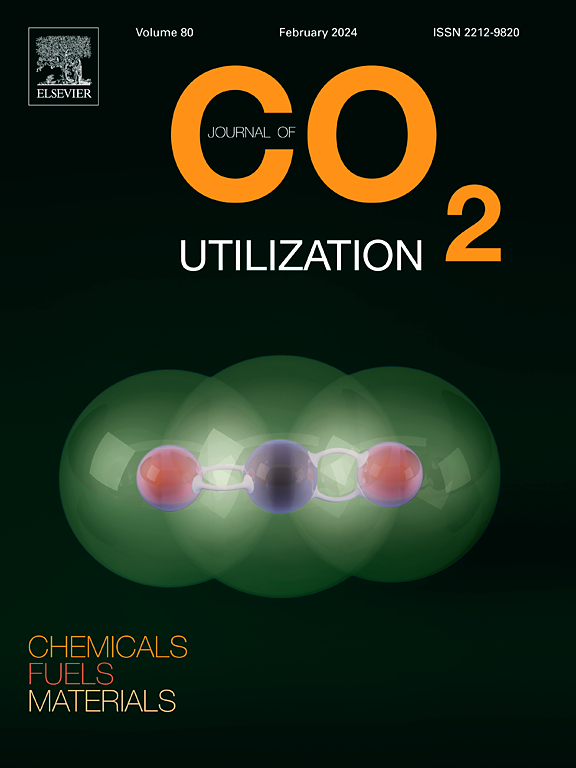通过优化电荷转移,高性能Bi2S3/ sn掺杂TiO2纳米纤维高效光催化CO2还原为甲醇
IF 8.4
2区 工程技术
Q1 CHEMISTRY, MULTIDISCIPLINARY
引用次数: 0
摘要
大气中二氧化碳含量的迅速增加是全球变暖的主要原因。二氧化碳光还原利用太阳能将二氧化碳转化为碳氢化合物燃料,是一种很有前途的减少大气中二氧化碳的方法。这些燃料与现有的能源基础设施兼容,使这种方法既实用又可持续。然而,它的实际实施需要在催化效率、电荷分离和产物选择性方面取得重大进展。在本研究中,我们采用静电纺丝和水热法设计并合成了Bi2S3/ sn掺杂的TiO2纳米纤维(Bi2S3/Sn-TiO2 NFs),在紫外-可见(UV-Vis)照射下实现了优异的光催化CO2还原效果。在模拟太阳光照下,Bi2S3/Sn-TiO2 NFs的CH3OH产量(529µmol/g·h)是Sn-TiO2 NFs(188µmol/g·h)和原始TiO2 NFs(80µmol/g·h)的三倍。这种显著的改善归功于1D Sn-TiO2 NFs结构和0D Bi2S3纳米颗粒的协同作用,前者促进了电荷的快速传输,后者增强了可见光的吸收,并作为CO2吸附和还原的活性位点。优化的s型异质结的形成促进了高效的界面电荷转移,抑制了重组损失,并确保了长时间的光催化稳定性。这些发现表明,0D/1D复合材料是一种高效、可扩展的co2 - ch3oh转化光催化剂,有助于推进碳中和能源技术的发展。本文章由计算机程序翻译,如有差异,请以英文原文为准。
High-performance Bi2S3/Sn-doped TiO2 nanofibers for efficient photocatalytic CO2 reduction to methanol via optimized charge transfer
The rapid increase in atmospheric CO2 levels is a major contributor to global warming. CO2 photoreduction, which utilizes solar energy to convert CO2 into hydrocarbon fuels, is a promising approach for reducing atmospheric CO2. These fuels are compatible with existing energy infrastructures, making this method both practical and sustainable. However, its practical implementation requires significant advancements in terms of catalytic efficiency, charge separation, and product selectivity. In this study, we design and synthesize Bi2S3/Sn-doped TiO2 nanofibers (Bi2S3/Sn-TiO2 NFs) by employing electrospinning and hydrothermal methods to achieve superior photocatalytic CO2 reduction under ultraviolet-visible (UV-Vis) irradiation. Under simulated solar light, Bi2S3/Sn-TiO2 NFs exhibit threefold enhancement in CH3OH production (529 µmol/g·h) compared to that of Sn-TiO2 NFs (188 µmol/g·h) and pristine TiO2 NFs (80 µmol/g·h). This significant improvement is attributed to the synergistic effect of 1D Sn-TiO2 NFs structure, which facilitates rapid charge transport, and 0D Bi2S3 nanoparticles, which enhance visible light absorption and act as active sites for CO2 adsorption and reduction. The formation of an optimized S-scheme heterojunction promoted efficient interfacial charge transfer, suppressed recombination losses, and ensured prolonged photocatalytic stability. These findings indicate that the 0D/1D composite is a highly efficient and scalable photocatalyst for CO2-to-CH3OH conversion, which contributes to the advancement of carbon-neutral energy technologies.
求助全文
通过发布文献求助,成功后即可免费获取论文全文。
去求助
来源期刊

Journal of CO2 Utilization
CHEMISTRY, MULTIDISCIPLINARY-ENGINEERING, CHEMICAL
CiteScore
13.90
自引率
10.40%
发文量
406
审稿时长
2.8 months
期刊介绍:
The Journal of CO2 Utilization offers a single, multi-disciplinary, scholarly platform for the exchange of novel research in the field of CO2 re-use for scientists and engineers in chemicals, fuels and materials.
The emphasis is on the dissemination of leading-edge research from basic science to the development of new processes, technologies and applications.
The Journal of CO2 Utilization publishes original peer-reviewed research papers, reviews, and short communications, including experimental and theoretical work, and analytical models and simulations.
 求助内容:
求助内容: 应助结果提醒方式:
应助结果提醒方式:


